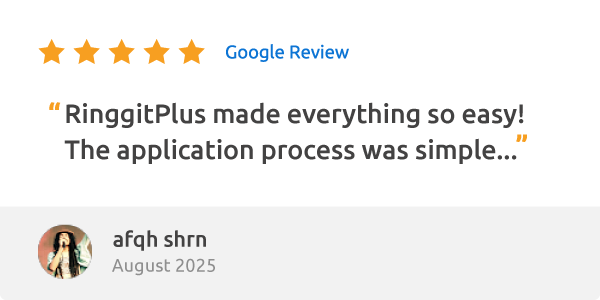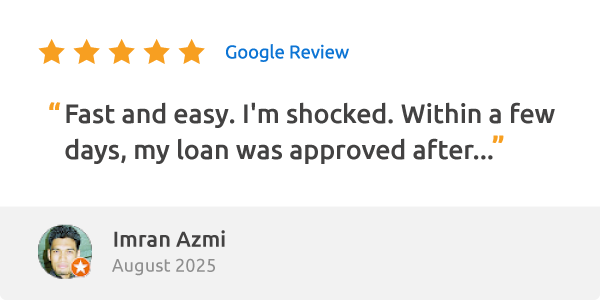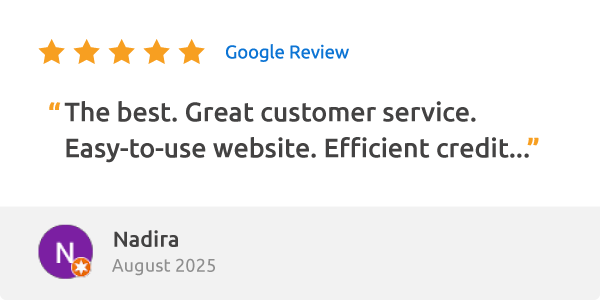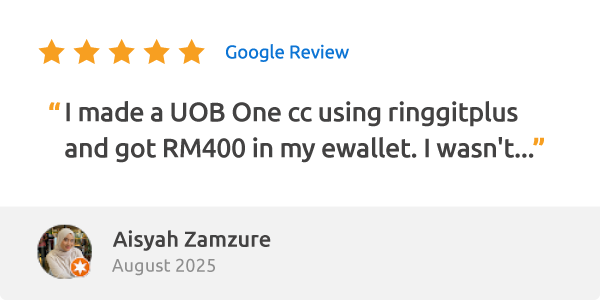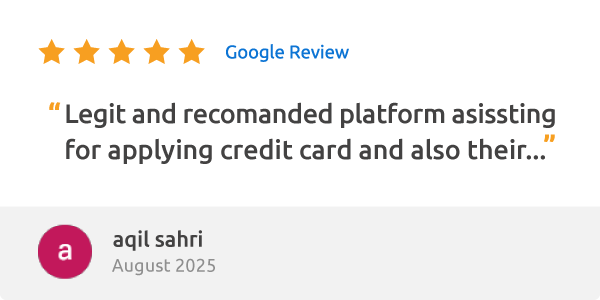Plan your home purchase with confidence. Get your estimated monthly payments in under a minute!
Why Use This Home Loan Calculator?
The RinggitPlus home loan calculator shows you three essential numbers before you start house hunting: your borrowing amount based on your down payment, the total interest, and the total loan payments you’ll pay throughout the loan tenure. These numbers determine which properties you can realistically afford.
When you use the calculator on this page, you'll get answers to these questions:
Your monthly payment amount: The fixed sum you must pay to the bank every month for the life of the loan.
Your total interest cost: The extra amount you'll pay on top of the property price over the entire loan tenure.
Once you know these numbers, you can confidently search for properties within your budget and compare home loan offers.
What Is A Home Loan?
A home loan (also called a mortgage) is money you borrow from a bank to buy a property. You repay this money in monthly instalments over a period called the loan tenure, which can be up to 35 years in Malaysia.
The bank uses your property as security for the loan. If you stop making payments, the bank has the legal right to take possession of your property and sell it to recover its money. Once you've paid back the full loan amount, the property belongs to you completely.
How much can you borrow? Malaysian banks typically lend up to 90% of the property's value. This means you must pay at least 10% of the property price as a down payment from your own savings. For a RM500,000 property, you need at least RM50,000 as a down payment, and the bank will lend you up to RM450,000.
What Information Does The Calculator Need?
The calculator needs four basic details to work out your costs:
The property price: This is the selling price of the home you want to buy. In Malaysia, property prices vary widely depending on location and type, from RM200,000 for affordable housing to several million Ringgit for premium properties.
Your down payment: This is the amount you'll pay from your own savings. The minimum is 10% of the property price. You can pay more if you want to borrow less from the bank.
The interest rate: This is the yearly cost the bank charges you to borrow money. Home loan interest rates in Malaysia typically range from 3.5% to 5% per year, depending on the bank and your credit profile.
The loan tenure: This is how many years you'll take to repay the loan. Malaysian banks offer tenures from 5 years up to 35 years. Your age matters here because most banks require you to fully repay the loan before you turn 70 years old.
Enter these four numbers into the calculator above, and it will show you your estimated monthly payment.
Understanding Your Upfront Costs
Many first-time buyers focus solely on the 10% down payment and get shocked when they discover the additional costs. Your total upfront cash requirement typically includes these separate payments:
Down payment: 10% (or up to 20%), and this goes directly to the property seller to secure your property before the loan application. For a RM500,000 property, this means RM50,000.
Stamp duty on the Memorandum of Transfer (MOT): This is the tax charged for transfers of property ownership to the buyer. 1% for the first RM100,000, 2% on the next RM400,000, and 3% on the subsequent amount.
Stamp duty on the Loan Agreement: The government also taxes your loan agreement, which is 0.5% of the total loan amount. For a RM450,000 loan, this is approximately RM2,250.
Legal fees for the Sale and Purchase Agreement (SPA): Your lawyer handles the paperwork for buying the property. This typically costs around RM6,000 for a RM500,000 property.
Legal fees for the Loan Agreement: Your lawyer also handles the loan paperwork with the bank. This fee is calculated based on the loan amount.
Valuation fees for the property: Banks require a valuation of your property to ensure that the loan amount is in line with the property's market value.
Processing fees: This is a nominal fee that the bank charges to process your home loan application. The typical range is around RM1,000 to RM2,000, depending on the bank. Some may charge more, or waive it entirely. Check with your bank or your loan agreement.
Types Of Home Loans In Malaysia
Malaysian banks offer three main types of home loans. Each type gives you different levels of flexibility in managing your repayments:
Basic Term Loan
This is the simplest type. You make the same monthly payment every month for the entire loan term. You cannot make extra payments to reduce your interest or access any overpayments. This loan typically offers the lowest interest rate because it gives you the least flexibility.
Semi-Flexi Loan
This is the most popular choice among Malaysian home buyers. You can make extra payments above your monthly instalment whenever you have spare cash. These extra payments reduce the interest you pay over time. If you need money later, you can withdraw these extra payments, though some banks charge a small fee or require paperwork. This offers a good balance between flexibility and cost.
Full-Flexi Loan
This gives you maximum flexibility. The bank links your home loan to a current account. Any money you deposit into this account automatically reduces your loan principal, lowering your daily interest charges. You can withdraw this money anytime without fees or paperwork. This loan typically has a slightly higher interest rate than the other types because of the extra flexibility.
How Interest Rates Work For Home Loans
Home loan interest rates in Malaysia work differently from personal loan rates. Understanding these differences helps you compare offers properly.
Base Rate (BR) or Base Lending Rate (BLR)
Banks calculate your interest rate by adding a percentage to their Base Rate. For example, if a bank's Base Rate is 2.5% and they offer you "BR + 1.2%", your interest rate is 3.7% per year. The Base Rate can change when Bank Negara Malaysia changes the Overnight Policy Rate (OPR). This means your monthly payment can go up or down over time.
Fixed Rate
Some banks offer a fixed interest rate for the first few years of your loan (typically 2 to 5 years). During this period, your interest rate and monthly payment stay the same regardless of OPR changes. After the fixed period ends, your loan usually converts to a variable rate based on the bank's Base Rate.
Effective Interest Rate (EIR)
This shows the true annual cost of your loan, including any fees the bank charges. Always ask for the EIR when comparing different home loan offers, as it gives you the most accurate comparison.
Understanding Loan Lock-In Periods
Many home loans come with a lock-in period, typically 3 to 5 years. During this time, if you want to fully repay your loan early (for example, by refinancing with another bank or selling the property), the bank will charge you a penalty fee.
This penalty is usually 2% to 3% of your original loan amount. On a RM450,000 loan, this means a penalty of RM9,000 to RM13,500. Some banks waive this penalty if you only make partial early repayments.
Always ask the bank about their lock-in period and penalty charges before you sign the loan agreement. If you think you might sell the property or refinance within a few years, look for loans with shorter lock-in periods or lower penalties.
Using Your EPF To Buy Your First Home
If you're a first-time home buyer in Malaysia, you can withdraw money from your Employees Provident Fund (EPF) Account 2 to help with your purchase. This can significantly reduce the cash you need upfront.
What you can withdraw: Up to 30% of your Account 2 balance or the full property price, whichever is lower. You can use this money for your down payment, legal fees, and stamp duty.
Eligibility requirements: You must be a Malaysian citizen aged 21 or above, buying your first property, and the property value must be under RM500,000.
How to apply: Submit your application through the EPF i-Akaun portal with your signed Sale and Purchase Agreement and loan approval letter. Processing takes approximately 14 working days.
Calculate how much EPF you have available before you start house hunting, as this affects how much cash you need to save separately.
Mortgage Insurance: MRTA vs MLTA
Most banks require you to buy mortgage insurance to protect the loan. This insurance pays off your home loan if you die or become permanently disabled before finishing the repayments. You'll encounter two types:
Mortgage Reducing Term Assurance (MRTA)
The coverage amount decreases as you pay down your loan. If you die early in the loan term, the insurance pays off the full remaining balance. If you die near the end of the term, it only pays off the small remaining balance. The bank is the beneficiary, meaning the insurance pays the bank directly. This is cheaper than MLTA because the coverage reduces over time.
Mortgage Level Term Assurance (MLTA)
The coverage amount stays fixed for the entire loan term. You can name anyone as the beneficiary, typically your family. If you die, your family receives the full coverage amount. They can use this to pay off the home loan and keep any remaining money. This costs more than MRTA but gives your family more financial protection.
Banks often strongly recommend MRTA because it protects their loan directly, but you're free to choose MLTA instead if you want better family protection.
How Loan Tenure Affects Your Total Cost
The loan tenure you choose creates a significant trade-off between monthly affordability and total interest paid. Understanding this helps you make a better decision.
Shorter tenures (15 to 20 years): Your monthly payment is higher, but you pay much less total interest. You also own your home outright much sooner. Choose a shorter tenure if your income is stable and you can comfortably afford the higher monthly payment.
Longer tenures (30 to 35 years): Your monthly payment is lower and easier to manage, but you pay significantly more total interest. You'll spend many more years making payments. Choose a longer tenure only if you need the lower monthly payment to qualify for the loan or manage your other expenses.
Real comparison for a RM450,000 loan at 4% interest:
- 20-year tenure: Monthly payment RM2,727, total interest RM204,480
- 30-year tenure: Monthly payment RM2,148, total interest RM323,280
- 35-year tenure: Monthly payment RM2,000, total interest RM390,000
The 35-year tenure costs you RM185,520 more in interest than the 20-year tenure, even though the monthly payment is RM727 lower. Use the calculator above to test different tenures with your own numbers.
Steps To Getting Your Home Loan Approved
Understanding the process helps you prepare properly and avoid delays. Here's what happens from application to getting your keys:
Step 1 - Financial preparation: Check your credit score through a Credit Rating Agency, such as CTOS, Experian, or Credit Bureau Malaysia. Clear any outstanding debts if possible. Save enough cash for your down payment plus the additional costs shown in the calculator.
Step 2 - Property search and loan application: Find a property you want to buy. Apply for loan pre-approval from at least three different banks to compare offers. Pre-approval shows sellers you're a serious buyer and helps you negotiate better.
Step 3 - Loan approval and legal work: Once the bank approves your loan, appoint a lawyer to handle the paperwork. Your lawyer prepares the Sale and Purchase Agreement with the seller and the Loan Agreement with the bank.
Step 4 - Signing and payment: Sign both agreements and pay all the upfront costs (down payment, legal fees, stamp duty). The bank conducts a property valuation to confirm that the property is worth the price.
Step 5 - Loan disbursement: The bank releases the loan amount to the seller. For new developments, the bank releases the money in stages as the developer completes construction. For subsale properties, the bank releases the full amount after you sign the agreement.
Step 6 - Getting your keys: Once the payment reaches the seller, you get your keys and can move into your new home. Your first monthly payment starts approximately one month after the bank releases the loan.
Common Questions About Home Loans
Navigating home loans can be tricky, so we've answered some common questions to help you get started.
Can I get a 100% home loan with no down payment?
Yes, under specific government schemes for first-time buyers. Skim Rumah Pertamaku (My First Home Scheme) offers 100% financing for eligible Malaysians. Requirements include property price caps (usually under RM500,000) and household income limits. Check if you qualify before assuming you need the full 10% down payment.
What's the difference between buying a new development and a subsale property?
A new development means buying directly from a property developer. The property is usually under construction, and you start payments as construction progresses. A subsale property means buying from the previous owner. The property is ready, and you can move in immediately after completing the purchase. Subsale properties often require faster loan disbursement and may need additional renovation costs.
What's the difference between freehold and leasehold properties?
Freehold means you own the property and land indefinitely. There's no time limit on your ownership. Leasehold means you own the property for a fixed period, typically 99 years. When the lease expires, ownership returns to the state government unless renewed. Freehold properties typically cost more but hold their value better long-term.
How does my credit score affect my home loan?
Your credit score directly impacts both your loan approval chances and the interest rate you receive. A higher score (above 700) typically gets you better interest rates, potentially saving you tens of thousands of Ringgit over the loan term. A lower score may result in loan rejection or higher interest rates. Check your credit score before applying.
Can I refinance my home loan later to get a better rate?
Yes, you can refinance your home loan by taking a new loan from a different bank to pay off your existing loan. This makes sense if interest rates have dropped significantly since you took your original loan. Remember to factor in the lock-in penalty from your current bank, legal fees for the new loan, and any fees the new bank charges. Refinancing usually makes financial sense if you can reduce your interest rate by at least 0.5% to 1%.
Should I choose a semi-flexi or full-flexi loan?
Choose based on your financial discipline and cash flow needs. A semi-flexi loan works well if you want to make occasional extra payments when you receive bonuses or windfall income. A full-flexi loan suits you better if you regularly have excess cash that you want to use to reduce interest, and you value the ability to withdraw it instantly without fees. The interest rate difference between the two is usually small, around 0.1% to 0.3%.
How much property can I actually afford?
Most banks follow the 30% debt service ratio rule. Your total monthly debt payments (including the new home loan) should not exceed 30% of your gross monthly income. For example, if you earn RM8,000 monthly, your total debt payments should stay under RM2,400. If you already have a RM500 car loan payment, your home loan payment should be under RM1,900. Use this calculator to find a monthly payment that fits this ratio.
What happens if I miss a monthly payment?
Missing a payment triggers several consequences. The bank charges you a late payment fee (typically RM50 to RM100) and additional daily interest on the overdue amount. Your credit score drops significantly, making it harder to get loans in the future. If you miss multiple payments (usually three or more consecutive months), the bank can start legal proceedings to auction your property. If you're struggling with payments, contact your bank immediately to discuss restructuring options.
Is the calculator's estimate accurate?
The calculator gives you an estimation for planning purposes. It uses standard formulas for monthly payments based on official scales. The final amounts from your bank and lawyer may differ slightly because of specific terms in your loan agreement, the actual property valuation, additional disbursement fees, or special promotional waivers.
Use the calculator's numbers for budgeting, but get exact quotations from banks and lawyers before you commit.
Ready to Compare Home Loan Offers?
You've used the calculator and know what you can afford. The next step is comparing actual home loan offers from different Malaysian banks.
Our home loan comparison page shows you current interest rates, loan features, and special promotions from major banks. You can filter by loan type and see which banks offer the best terms for your needs.
Visit our home loan comparison page to find your best home loan match!






